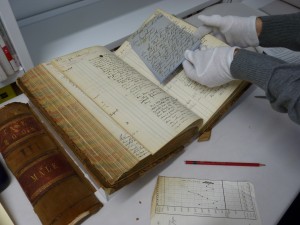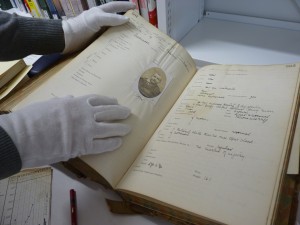A gap in the Scottish archival record has been filled with the transfer of the archives of Stirling District Asylum to the University of Stirling. Part of a larger transfer of historical records to the University Archives by NHS Forth Valley, the records of Stirling District Asylum (later known as Bellsdyke Hospital) provide a detailed account of the care and treatment of mental health patients in Central Scotland in the late nineteenth and early twentieth centuries. This semester we have begun work on a project with a team of student volunteers (thanks Catherine, David, Ian and Jennifer!) to prepare these records for public consultation in our archives reading room.

The project team will be working on a set of 50 volumes of case books which provide detailed records of the care and condition of patients in the hospital beginning in 1869. These volumes were working documents, regularly updated by medical staff. They include many enclosures relating to the treatment of patients – both medical records such as temperature charts and personal material such as correspondence. From the 1890s onwards the case books also include photographs of the patients which are pasted onto the pages of the volumes, a common practice also seen in contemporary case books from other Scottish asylums.

Basic cleaning of the volumes is being carried out, with dust and surface dirt being removed using conservation-quality natural hair brushes. The enclosures, many of which are secured to the pages of the volumes with metal clips and pins are being carefully removed to be stored alongside the volumes. Further cleaning of the pages of the volumes is then carried out where required using chemical sponges – conservation-quality cleaners which carefully remove the dust and grime which has accumulated over more than a century of use and storage.

Once cleaned and catalogued these volumes will be made available for use in our archives reading room. Academic researchers across a range of disciplines will find a wealth of social, historical and medical material in the records. Comparative studies with other Scottish Asylums will also be possible for the first time. The collection will also be of interest to family historians, opening up a new source of genealogical information.